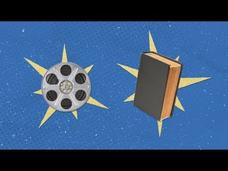TED-Ed
The Chaotic Brilliance of Artist Jean-Michel Basquiat
In 2017 a work by Jean-Michel Basquiat was actioned off for over 110 million dollars. So who is he and what makes his art so special? Find out with a short video that details his background, influences, and his process.
Learning Upgrade
Main Idea Song
Tap your toes and give a snap to a jazz inspired song showcasing a paragraph's main idea. Pupils hear about a paragraph's structure, including its topic sentence, supporting details, and the conclusion, and how they relate to identifying...
Learning Upgrade
Verbs 1 Song
Sing along with a short, animated video that defines, provides examples of different types of verbs, and models how they operate in a sentence.
Age of Learning
The Letter L Song
As the song says, "Once this song is through, you'll know how to tell, the words that begin with the letter L." Listen and sing along to the melodic tune of an instructional video highlighting L-letter words.
PBS
When the Book is Better than the Movie
Sometimes the book is better than the movie; other times, the movie comes out on top. A video discusses the topic of novels and their film adaptations, pointing out specific texts and how the tale translated to the big screen. The...
TED-Ed
Why Should You Read Sylvia Plath?
Are the works of Sylvia Plath relevant to the modern reader? The narrator of a short video argues for why viewers should read the works of Sylvia Plath, citing lines from Plath's poetry and images from her stories.
Curated OER
Phonics Song - 2 - The Blends
Two letters pop up on the screen; each sound is said separately, blended together, and finally as part of a word. A picture pops up to visually display the word as well. Two words appear for each blend.
Crash Course
Before I Got My Eye Put Out - The Poetry of Emily Dickinson
Everything you wanted to know about Emily Dickinson in 10 minutes. John Green’s rapid pace and hyperkinetic personae may not appeal to all viewers, but the video is, as advertised, a crash course in Dickinson’s life and her poetry. A...
Crash Course
In the Mood for Love
English-speaking viewers don't need to read the subtitles to understand Wong Kar-Wai's In the Mood For Love. The colors, the music, and the framing of the shots so beautifully express the emotions of the characters that dialogue, in any...
TED-Ed
The Myth of Sisyphus
Having an eagle eat your liver sounds like a form of cruel and unusual punishment. As explained in an interesting video lesson, it's nothing compared to the punishments doled out in "The Myth of Sisyphus." A summary introduces the...
TED-Ed
Why Should You Read “The Master and Margarita”?
The best Russian novel of the 20th century? The narrator of an interesting short video offers reasons why readers should tackle Mikhail Bulgakov's satirical comedy, The Master and Margarita.
British Council
Dolphins Know the Best Way to Catch Fish
Humans often struggle to catch fish, but dolphins have the process down to an art. A video explores the brains of the intelligent porpoises, focusing specifically on their superior methods of catching fish. Two reading comprehension...
ABCMouse
Big Bug and Little Bug
Impart the value of kindness and reinforce rhyming CVC words with a short video about a bug who offers help to another bug in need.
Curated OER
Phonics Song - 1 - The Basics
An object pops up on the screen for each letter of the alphabet, accompanied by the letter itself and the name of the object. The objects are drawn in black and white and the letters pop up in red.
Be Smart
Why Are Some People Left-Handed?
Most animals that show a paw preference are split 50/50 with half of the population preferring one side and the other half preferring the other, yet in humans only 10 percent are left-handed. The video explains what part of the brain...
Be Smart
How Some Words Get Forgetted
There's nothing regular about them—irregular verbs turn out to be the most common verbs in the English language. Through an analysis of data, learners discover that Zipf's Law describes the patterns of word usage.
Crash Course
Movies are Magic
Persistence of Vision? The Phi Phenomenon? Zoetropes? Camera Obscura? Kinetograph? What part do these concepts and inventions play in the history of movies? Find out with a short video that launches an informative playlist on film history.
Curated OER
Engineering an Empire - The Maya, 5/5
Concluding the five-part series on the Mayan Empire we discover the disease and Conquistadors that lead to the demise of the Mayan people. While this does touch upon the devastation that all but destroyed the Mayan civilization, the over...
Be Smart
What's The Loudest Possible Sound?
If a tree falls in the forest and no person is around, does it still make a sound? Students view a short video segment to determine sound and decibel levels of various objects, including the loudest and quietest possible sounds humans...
Curated OER
Same And Different
Zoe and Big Bird define the concept of the same and different by comparing themselves. They identify the ways they are the same and the ways they are different. This video could be used as an introduction to comparing objects.
MinuteEarth
Garbage Doesn't Lie
What does your garbage say about you? Young scientists dig through a video about things people cast aside. The narrator shows the fascinating things in George Washington's garbage pile, ancient Roman garbage, and how the landfills we...
Other popular searches
- English Language Arts Music
- Music and Language Arts
- Language Arts Musician
- Language Arts Music Theme
- Music Language Arts
- Music With Language Arts
- Art and Music Language Arts
- Music Language Arts Tiered
- Rap Music Language Arts
- Music Language Arts Teired






















